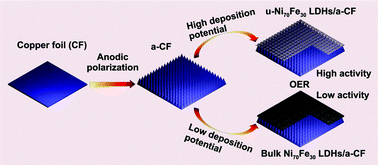In situ growth of ultrathin Ni–Fe LDH nanosheets for high performance oxygen evolution reaction†
Abstract
Layered double hydroxides (LDHs) are increasingly being recognized as one of the most promising candidates to lower the oxygen evolution reaction (OER) barriers in water splitting. However, how to further increase catalytically active sites and then improve the corresponding catalytic activity is still a great challenge, which is critical for the design of an efficient OER electrocatalyst. Here, we present the in situ growth of ultrathin Ni–Fe LDH (u-Ni70Fe30 LDHs) nanosheets rich in catalytically active sites on the anodic polarized copper foil as an efficient electrocatalyst for OER through a mild electrodeposition approach (denoted as u-Ni70Fe30 LDHs/a-CF). We found that the u-Ni70Fe30 LDHs/a-CF shows a remarkable catalytic activity (the overpotential of 260 mV at 10 mA cm−2) and superior catalytic stability (beyond 50 h) in basic media. The achieved ultrahigh catalytic performance of u-Ni70Fe30 LDHs/a-CF is primarily attributed to its ultrathin nanosheet structure, the optimized 30 at% Fe-dopant concentration, and the synergetic effect between the nanosheets and the bumps on a-CF. These reasons lead to the high density of exposed active sites and the improved mass/electron transport capability. In comparison with the other developed LDH based electrocatalysts reported to date, we provide a controllable and mild strategy for designing highly-efficient ultrathin LDH based electrocatalysts with desirable kinetics for future large-scale application in water splitting.



 Please wait while we load your content...
Please wait while we load your content...